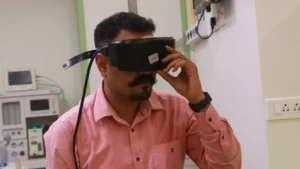Understanding the Diagnosis of Vertigo
Vertigo, which is typified by a spinning or lightheaded feeling, can have a major effect on day-to-day functioning. Determining the root cause of vertigo is crucial for managing and treating it effectively. We’ll go over the entire process of diagnosing vertigo in this guide, from gathering medical history to conducting physical exams and diagnostic tests.
The Importance of Accurate Diagnosis of Vertigo
Effective treatment of vertigo begins with an accurate diagnosis. In order to reduce symptoms and enhance quality of life, medical professionals can customise therapy regimens by pinpointing the precise cause. Starting with the first step of obtaining a patient’s medical history, let’s explore the diagnostic process.
Gathering Medical History: The First Step

Image Source: Canva
An in-depth examination of the patient’s symptoms, prior medical issues, and pertinent lifestyle factors is required while compiling a thorough medical history. Healthcare professionals elicit information on the nature and circumstances of a patient’s vertigo episodes using asking inquiries during a medical interview.
1. Medical Interviews
Medical interviews serve as a vital tool for understanding the patient’s vertigo experience. Healthcare providers inquire about:
- The frequency, duration, and severity of vertigo episodes, seeking to understand the impact on daily activities and quality of life
- Any triggering or exacerbating factors, such as changes in position, stress, or specific activities
- Associated symptoms like hearing loss, ear pain, visual disturbances, nausea, or vomiting
- Any recent illnesses, injuries, or changes in medications, which may provide valuable clues about the underlying cause of vertigo
2. Lifestyle and Environmental Factors
Exploring lifestyle and environmental factors can offer valuable clues about potential triggers for vertigo. Providers may inquire about:
- Dietary habits, including caffeine or alcohol consumption, as certain substances can exacerbate vertigo symptoms
- Exposure to environmental toxins or allergens, such as cigarette smoke, chemical fumes, or pollen
- Recent travel, altitude changes, or occupational hazards, which may be associated with vertigo-inducing factors like motion sickness or inner ear barotrauma
- Sleep patterns, stress levels, and overall quality of life, as stress and fatigue can contribute to vertigo episodes
Conducting Physical Exams

Physical examinations play a pivotal role in assessing balance, coordination, and neurological function. By observing the patient’s movements and responses, healthcare providers can gather valuable diagnostic information.
1. Evaluation of Balance and Coordination
Tests such as the Romberg test and Dix-Hallpike maneuver help assess the patient’s balance and vestibular function:
- The Romberg test evaluates the patient’s ability to maintain balance with eyes closed, which can indicate vestibular dysfunction or proprioceptive deficits
- The Dix-Hallpike maneuver is used to diagnose benign paroxysmal positional vertigo (BPPV), a common cause of vertigo characterized by brief episodes triggered by changes in head position
2. Examination of Ear and Eye Movement
Examining ear and eye movements provides insights into the integrity of the vestibular system:
- Nystagmus, involuntary rhythmic eye movements, can indicate abnormalities in vestibular function or central nervous system dysfunction
- Otoscopic examination allows visualization of the ear canal and tympanic membrane, helping to identify signs of infection, inflammation, or structural abnormalities that may be contributing to vertigo symptoms
Diagnostic Tests

Image Source: Canva
When physical exams and medical history aren’t sufficient to pinpoint the cause of vertigo, healthcare providers may recommend additional diagnostic tests to gather further information.
1. Vestibular Function Tests
Specialized tests such as electronystagmography (ENG) and videonystagmography (VNG) assess the function of the inner ear and vestibular system:
- These tests measure eye movements in response to various stimuli, helping to identify abnormalities in vestibular function such as unilateral weakness or canalithiasis
- Caloric testing, another vestibular function test, involves irrigating the ear canal with warm and cold water to evaluate the vestibular response and assess the integrity of the vestibulo-ocular reflex
2. Imaging Studies
Imaging studies such as magnetic resonance imaging (MRI) and computed tomography (CT) scans visualize the structures of the inner ear and brain:
- These studies can detect structural abnormalities such as tumors, lesions, or vascular malformations that may be causing vertigo symptoms
- High-resolution imaging techniques provide detailed anatomical information, facilitating accurate diagnosis and treatment planning
3. Blood Tests
Blood tests may be ordered to assess various factors contributing to vertigo:
- Glucose levels, electrolyte balance, and markers of inflammation can provide valuable diagnostic information, particularly in cases of metabolic or systemic disorders
- Blood tests can also help identify systemic conditions such as autoimmune disorders, thyroid dysfunction, or infections that may manifest with vertigo symptoms
Conclusion
Accurate diagnosis of vertigo requires a multidimensional approach, spanning medical history, physical exams, and diagnostic tests. By collaborating with healthcare providers and actively participating in the diagnostic process, patients can gain insights into the root cause of their vertigo and explore personalized treatment options. If you’re having vertigo symptoms, don’t hesitate to seek timely medical guidance. With accurate diagnosis and targeted treatment, you can navigate the challenges of vertigo and improve your general quality of life.
FAQ’s
What is Vertigo?
– Vertigo is a sensation of feeling off balance or spinning, which can be caused by various factors such as inner ear problems, neurological disorders, or other medical conditions. It can significantly impact daily life and quality of life.
What are the Common Causes of Vertigo?
– Common causes of vertigo include benign paroxysmal positional vertigo (BPPV), Meniere’s disease, vestibular neuritis, labyrinthitis, and migraines. Other factors such as head injuries, infections, and certain medications can also contribute to vertigo.
How is Vertigo Diagnosed?
– Diagnosing vertigo involves a comprehensive approach, including medical history, physical exams, and diagnostic tests. Healthcare providers gather information about symptoms, medical history, and lifestyle factors, and conduct physical exams to assess balance and coordination. Diagnostic tests such as vestibular function tests, imaging studies, and blood tests may be ordered to identify the underlying cause.
What are the Treatment Options for Vertigo?
– Treatment for vertigo depends on the underlying cause. Options include medications, balance exercises, vestibular rehabilitation therapy, and surgery. Medications such as antihistamines, anticholinergics, and corticosteroids can help alleviate symptoms. Balance exercises and vestibular rehabilitation therapy can improve balance and reduce vertigo episodes.
Can Vertigo be Treated without Surgery?
– Yes, many cases of vertigo can be treated without surgery. Medications, balance exercises, and vestibular rehabilitation therapy are often effective in managing symptoms. Surgery is typically reserved for cases where structural issues or other medical conditions are the root cause of vertigo and other treatments have not been effective.
How Long Does it Take to Diagnose Vertigo?
– The time it takes to diagnose vertigo can vary depending on the complexity of the case and the availability of diagnostic tests. In general, a thorough medical history and physical exam can help identify the underlying cause within a few weeks. Additional diagnostic tests may be necessary to confirm the diagnosis.
Can Vertigo Be Prevented?
– While some cases of vertigo are unavoidable, certain lifestyle changes and precautions can help reduce the risk of developing vertigo. These include avoiding sudden movements, maintaining good ear hygiene, and managing stress levels.
How Can I Manage Vertigo Symptoms?
– Managing vertigo symptoms involves a combination of lifestyle changes, medications, and therapies. Avoiding triggers, maintaining a healthy diet, and practicing relaxation techniques such as meditation or deep breathing can help alleviate symptoms. Medications and vestibular rehabilitation therapy can also be effective in managing vertigo episodes.
Can Vertigo be Cured?
– While some cases of vertigo can be cured, others may require ongoing management. The effectiveness of treatment depends on the underlying cause and the individual’s response to therapy. In some cases, vertigo may persist even after treatment.
How Can I Find a Specialist for Vertigo Treatment?
– To find a specialist for vertigo treatment, you can start by consulting your primary care physician or a general practitioner. They can refer you to a specialist such as an ear, nose, and throat (ENT) doctor, a neurologist, or a physical therapist with expertise in vestibular rehabilitation therapy.
